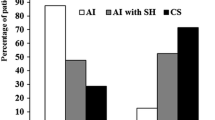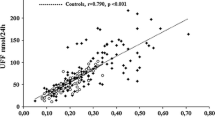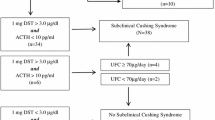Abstract
The value of dehydroepiandrosterone sulfate (DHEA-S), a specific marker of adrenal androgen production, in the assessment of clinical states of hypercortisolism and hypocortisolism has been suggested. Since the way to simply test for ACTH reserve in patients (pts) with pituitary tumors after adenomectomy is not standardized, in this study serum DHEA-S concentration was measured in order to establish whether its determination might be a sensitive index of ACTH deficiency. Serum DHEA-S concentration was evaluated in 29 pts with hypothalamic-pituitary tumors (16 females, 13 males, aged 20–70 yr), 14 of whom had GH-secreting ade-nomas, 13 nonfunctioning adenomas, 1 prolactinoma and 1 craniopharyngioma. Serum DHEA-S and Cortisol (F) levels were determined both before and every day for 8 days after pituitary adenomectomy. Before surgery in all pts mean DHEA-S and F basal values were 3.57±0.42 μmol/L and 391.8±29.0 nmol/L, respectively. Eight out of 29 pts showed reduced DHEA-S levels (0.85±0.19 μmol/L), which remained lower than normal in the postsurgical period; on the contrary, F levels were reduced in only 2 and 3 cases before and after surgery, respectively. In 3 other pts DHEA-S levels were normal before surgery and then were low in the postoperative period, while serum Cortisol remained normal in all cases. In most of these patients, the finding of impaired responses to hypothalamic-pituitary-adrenal tests, together with a reduced corticosteroid urinary excretion, confirmed the existence of a secondary hy-poadrenalism and the necessity for an adequate replacement therapy.The remaining 20 pts showed normal DHEA-S and F levels both before and after adenomectomy and did not require replacement therapy. In conclusion: a) in pts operated on by pituitary adenomectomy the determination of serum DHEA-S is useful in order to recognize secondary hypoadrenalism; b) the reduction of DHEA-S levels is accompanied to either altered responsiveness to dynamic tests or low corticosteroids urinary excretion; c) the simultaneous evaluation of DHEA-S and Cortisol levels is suggested in order to early identify pts who will show a secondary hypoadrenalism.
Similar content being viewed by others
References
Cutler G.B., Davis S.E., Johnsonbaugh R.E., Loriaux D.L Dissociation of Cortisol and adrenal androgen secretion in patients with secondary adrenal insufficiency. J. Clin. Endocrinol. Metab. 49:604,1979.
Yamaji T., Ishibashi M., Takaku F., Itabashi A. Serum dehydroepiandrosterone sulfate concentrations in secondary adrenal insufficiency. J. Clin. Endocrinol. Metab. 65:448,1987.
Yamaji T., Ishibashi M., Sekikara H., Itabashi A., Yanaihara T. Serum dehydroepiandrosterone sulfate in Cushing’ s syndrome. J. Clin. Endocrinol. Metab. 59:11 64,1984.
Burke C.W. Hormonal testing of pituitary tumours. In: Faglia G., Beck-Peccoz P., Ambrosi B., Travaglini P., Spada A. (Eds.), Pituitary Adenomas: New Trends in Basic and Clinical Research. Intern. Congr.Series 961. Excerpta Medica, Amsterdam, 1991, p. 181.
Donald R. Plasma immuno reactive corticotrophin and Cortisol response to insulin hypoglycemia in normal subjects and in patients with pituitary disease. J. Clin. Endocrinol. Metab. 32: 225, 1971.
Wand G.S., Ney R.L. Disorders of the hypothalamic-pituitary-adrenal axis. Clin. Endocrinol. Metab. 74:33,1985.
Kehlet H., Blichert-Toft M., Lindholm J., Rasmussen P. Short ACTH test in assessing hypothalamic-pituitary- adrenocortical function. Br. Med. J. 7:249,1976.
Borst G.C., Michenfelder H.J., O’Brian J.T. Discordant Cortisol response to exogenous ACTH and insulin induced hypoglycaemia in patients with pituitary disease. N. Engl. J. Med. 306: 1462, 1982.
Cunningham S.K., Moore A., McKenna T.J. Normal Cortisol response to corticotrophin in patients with secondary failure. Arch. Intern. Med. 743:2276,1983.
Hagg E., Asplund K., Lithner F. Value of basal plasma Cortisol assays in the assessment of pituitary-adrenal insufficiency. Clin. Endocrinol. (Oxf.) 26: 221,1986.
Hartzband P.I., Van Herle A., Sorger L, Cope D. Assessment of hypothalamic-pituitary-adrenal axis dysfunction: comparison of ACTH stimulation, insulin- hypoglycemia and metyrapone. J. Endocrinol. Invest. 77:769,1988.
Faglia G., Ambrosi B., Beck -Peccoz P., Travaglini P. Hypothalamic-pituitary-adrenal function in patients with pituitary tumors. Acta Endocrinol. (Copenh.) 73:223, 1973.
Snyder P.J., Jacobs L.S., Rabello M.M., Sterling F.M., Shore R.N., Utiger R.D., Daughaday W.H. Diagnostic value of thyrotrophin-releasing hormone in pituitary and hypothalamic diseases: assessment of thyrotropin and prolactin secretion in 100 patients Ann. Intern. Med. 81: 751,1974.
Tsatsoulis A., Shalet S.M., Harrison J., Ratcliffe W.A., Beardwell C.G., Robinson E.L. Adrenocorticotrophin deficiency undetected by stan dard dynamic tests of the hypothalamic-pituitary- adrenal axis. Clin. Endocrinol. (Oxf.) 28:225,1988.
Kehlet H., Binder C, Blichert-Toft M. Glucocorticoid maintenance therapy following adrenalectomy: assessment of dosage and prepa ration. Clin. Endocrinol. (Oxf.) 5:37,1976.
Kehlet H., Nistrup Masden S., Binder C. Cortisol and cortisone acetate in parenteral gluco-corticoid therapy? Acta Med. Scand. 195:421,1974.
Jenkins J.S., Sampson P.A. Conversion of cortisone to Cortisol and prednisone to prednisolone. Br. Med. J. 2: 205, 1967.
Hout W.M., Arafah B.M., Salazar R., Selman W. Evaluation of the hypothalamic-pituitary-adrenal axis immediately after pituitary adenomectomy: is perioperative steroid therapy necessary? J. Clin. Endocrinol. Metab. 66:1208,1988.
Udelsman R., Norton J.A, Jelenich S.E., Goldstein D.S., Linehan W.M., Loriaux D.L, Chrousos G.P. Responses of the hypothalamic-pituitary-adrenal and renin-angiotensin axes and the sympathetic system during controlled surgical and anesthetic stress. J. Clin. Endocrinol. Metab. 64: 986,1987.
Parker L.N., Odell W.D. Control of adrenal androgen secretion. Endocr. Rev. 1:392,1980.
Author information
Authors and Affiliations
Rights and permissions
About this article
Cite this article
Ambrosi, B., Bochicchio, D., Peverelli, S. et al. Value of serum dehydroepiandrosterone sulfate assay in the evaluation of pituitary-adrenal insufficiency after pituitary adenomectomy. J Endocrinol Invest 15, 827–833 (1992). https://doi.org/10.1007/BF03348813
Received:
Accepted:
Published:
Issue Date:
DOI: https://doi.org/10.1007/BF03348813




